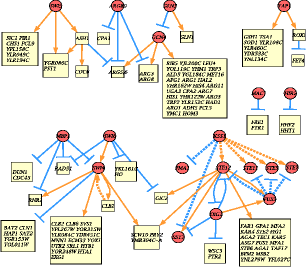IDEKER LABORATORY
University of California, San Diego
|
Lab Members' Research Projects Network-based Diagnosis and Personalized Medicine Error Analysis and Modeling of DNA microarrays |
| Comparative Network Analysis |
|
Large networks of molecular interactions, now being generated at high throughput by dozens of labs, provide a powerful framework for constructing complete models of cellular processes and disease. We have developed an approach for comparing protein interaction networks across multiple species to identify protein pathways and complexes that have been conserved over evolution (PathBLAST and NetworkBLAST). Evolutionarily conserved pathways allow interpretation of the network of a poorly-understood organism based on its similarity to that of a well-known species. These tools have application to infectious disease, for example by targeting drugs to pathways that are present in a pathogenic organism but absent from its human host. In collaboration with Dr. Stanley Fields and Prolexys Pharmaceuticals, we have recently applied our PathBLAST comparison tool to study the protein interaction network of Plasmodium, the pathogenic protozoan that causes malaria. Surprisingly, we found that very few regions of the Plasmodium protein network were homologous to the available protein networks of yeast, fly, worm, or bacteria [Suthram et al. Nature 2005]. A current roadblock to advancing Comparative Network Biology as a field is the marked lack of interaction maps at high coverage and at the appropriate distances for evolutionary comparison. To address this shortcoming, we are working with the Krogan lab at UCSF to obtain high-density physical and genetic interaction maps across the model organisms Schizosaccharomyces pombe and Saccharomyces cerevisiae [Roguev et al. Science 2008]. The last common ancestor of S. pombe and S. cerevisiae is quite ancient (420 mya), making the conserved interaction map generalizable to large parts of the eukaryotic lineage. Many aspects of S. pombe physiology bear more in common with mammals than does S. cerevisiae, including intron/exon splicing, chromosomal architecture, and RNA interference machinery. To define an appropriate scope for the interaction mapping efforts, our current screens are targeted to a set of ~400 proteins covering the majority of kinases and DNA-binding transcription factors. Comparative network analysis in the lab is funded by grants GM084279 and IIS-0803937.
|
